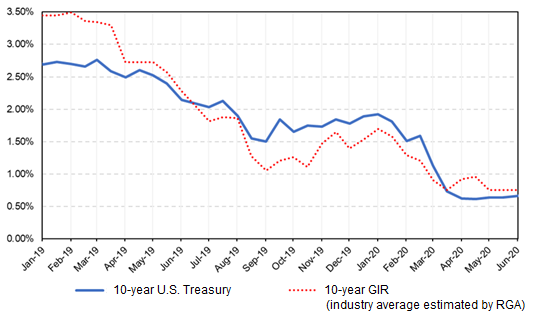Pandemic-fueled market volatility and economic disruption have challenged insurers' product portfolios and pricing strategies around the world. This article takes a closer look at the use of coinsurance as a potential protection solution for carriers of foreign currency-denominated single premium savings products in Japan – a strategy that may offer insights for insurers facing similar challenges in other markets.
The relative competitiveness of an insurer-issued saving product frequently relies on the insurer’s asset investment capability. For higher yields in the current and prolonged low interest rate environment, Japanese insurers have been using foreign currency (FC)-denominated bonds in their investment and product development strategies.
U.S. Treasury yields, however, which are the reference rates for U.S. dollar-denominated insurance products, have declined in recent years, and the rate of decline has recently accelerated due to the recent economic downturn from the COVID-19 pandemic. Indeed, in March, the U.S. Federal Reserve Bank cut its benchmark federal funds rate to between 0% and 0.25%. In response, central banks around the world raced to lower their interest rates. And with COVID-19 and its fallout continuing to spread worldwide, economic challenges will likely persist.
Figure 1: 10-year U.S. Treasury bond yields vs. 10-year industry average GIR (RGA)

In Figure 1, the blue line indicates yields of U.S. 10-year Treasury bonds since January 2019, and the red line shows GIRs credited to policyholders of Japanese single premium (SP) U.S. dollar-denominated products over the same time period. GIRs, as is clear from Figure 1, are closely aligned with U.S. Treasury bond yields. Generally, Japanese insurers update their GIRs for SP products either every two weeks or monthly, depending on the company and the investment environment.
The pandemic-driven changes in the investment environment, especially at the end of Japan’s fiscal 2019 (March 31, 2020), when global market volatility suddenly increased, have pushed insurance companies in the country to review their product development as well as sales strategies. Some insurers even stopped selling FC-denominated SP products entirely, which is indicative of the huge impact of interest rate volatility amid the pandemic.
The embedded issue
Changes in the environment surrounding FC-denominated SP products are highlighting several challenges for these products. The following three are worth noting:
- Although FC-denominated instruments generally have higher yields, the recent interest rate reductions of U.S. Treasuries have increased investment volatility for U.S. currency-denominated SP products. And even though insurance companies regularly review their GIRs for these products, they still must accommodate changes that may occur between the scheduled review dates. If insurers cannot review and then make adjustments when and as needed, they may have to stop selling the products immediately.
- Most FC-denominated products have a market value adjustment (MVA) feature, which enables products to adjust their cash surrender values in accordance with interest rate levels at surrender. This feature is necessary to mitigate asset disposal risk (i.e., the risk of incurring losses when selling assets of declined values in order to facilitate a surrender), as well as the risk of mass surrender scenarios, both of which can put pressure on an insurer’s balance sheet. Declining interest rates can also frequently lead to reserve strengthening needs for FC-denominated products, as MVAs driven by declining interest rates will impact insurers’ balance sheet liabilities. If assets are not adjusted for market value, losses in amounts equivalent to reserve strength need to be recognized. The repercussions so far have been huge, especially in the rapidly declining interest rate environment seen since the coronavirus spread. Even if assets are measured by market value, duration of the liabilities will still often exceed that of assets backing the liabilities. In this case, the value of the surplus, or the difference in market value between a given asset and liability, will be also impaired if interest rates are declining.
- Profitability counts. FC-denominated SP products are one of the flagship products for Japan’s independent and bancassurance agents. Before the pandemic, fierce price competition as well as declining interest rates were already cutting into their profitability. The rapid economic and interest rate declines since then, combined with reduced sales or recent needs to revise product sales strategies due to COVID-19, have made these products less attractive.
Coinsurance
Coinsurance can be a viable alternative to product revision or investment strategy review as a way insurers can retain and protect the value and viability of their FC-denominated SP product portfolios.
In full-risk coinsurance, all risks, including asset and liability risks, are transferred to a reinsurer. The reinsurer assumes responsibility for asset investment, which means a ceding company would not need to respond to market volatilities, as all (or an agreed-upon percentage) of the risk will be mitigated. Coinsurance also transfers product liabilities (reserves) to the reinsurer, which enables cedants to avoid reserve burden, including the need to strengthen reserves due to the need for MVA in a declining interest rate environment or to eliminate pressures on accounting income.
Reinsurers with expertise in FC-denominated bonds can add value for cedants that coinsure with them. These reinsurers can return to ceding companies a part of the spread gained through an investment strategy that incorporates FC-denominated bonds. For example, some SP products can guarantee foreign bond index yields, and the difference between that yield and that of the GIR can be offered to ceding companies as trail commissions. Thus, ceding companies can have some flexibility in setting their GIRs, depending on market environments and the competitive landscape, while also mitigating the product profitability issue.
Considerations
Coinsurance could solve some current challenges faced today by insurance companies in Japan. That being said, here are some general considerations:
- The coinsurance treaty should establish reinsurance administration flows that allow coinsuring reinsurers to invest smoothly in assets backing the reinsured business and to earn sufficient yields. Cedants might also benefit from providing reinsurance accounts or reports more frequently – perhaps monthly or even biweekly – than the typical quarterly cycle of many reinsurance treaties, and with substantially greater detail.
- Investment guidelines and other conditions for the collateral are very important for cedants and reinsurers. Coinsurance is usually a large transaction, and collateral is generally set to reduce counterparty risk to reinsurers. Guidelines that allow reinsurers flexibility in how they invest are a good idea, and at the same time it is also advisable to earmark some asset classes that reinsurers can invest at their discretion to improve investment yields. These assets would be apart from those required to mitigate reinsurer counterparty risk.
- Not all FC SP products may be suitable for full-risk transfer (i.e., vanilla) coinsurance. In some cases, it may be difficult for cedants to find reinsurers that will accept all the risks of these products. For example, their riders might generate mass surrenders under certain circumstances. Adverse financial conditions, the quality and effectiveness of a carrier’s MVA formula, the length of the liability duration, and/or target GIR levels may put some constraints on the design and conditions of the coinsurance as well.
Summary
The recent economic challenges stemming from the COVID-19 pandemic have caused FC-denominated SP savings products to come under increased and uncomfortable scrutiny. Coinsurance can be a possible protection solution for carriers of these products, as it can ease many of the risks brought to the fore by the current environment. Although coinsurance’s popularity in Japan has been rising. its structures, effects, and potential benefits are still not well known. It is advisable to work with a knowledgeable reinsurer which can help insurers understand how this strategy can improve prospects for their FC-denominated SP product portfolios.




